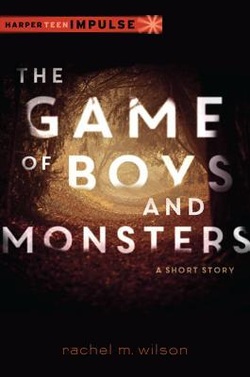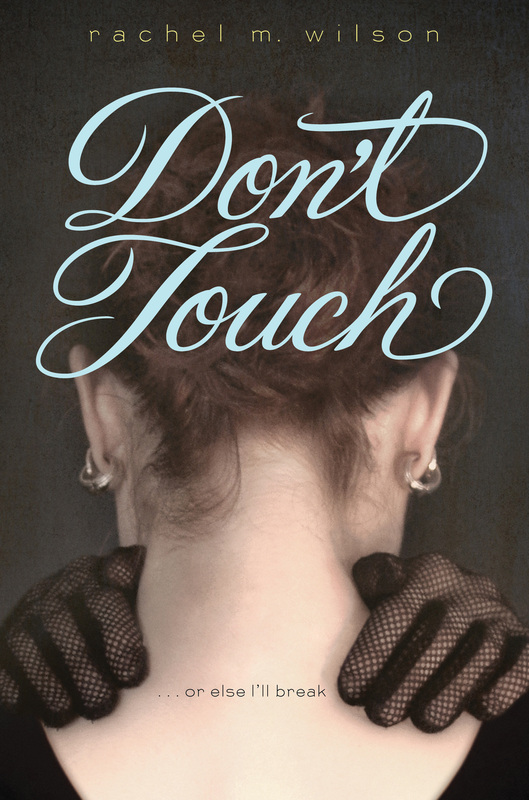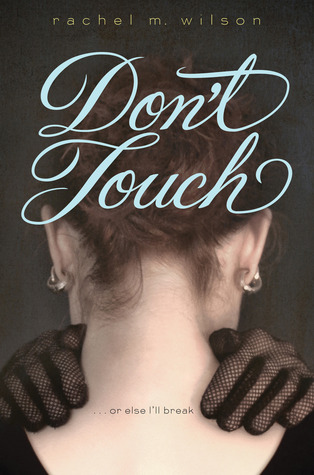|
Exciting news! I have two newly scheduled book launch events.
Whether or not you're able to make it to one of these events, these are also great places to pre-order Don't Touch and support a couple of excellent independent bookstores!
1 Comment
Some of my goofy theater friends got together for a Memorial Day BBQ and managed to sneakily film this in my presence without me catching on. Victoria R. Golden asked these nuts what they thought my book was about--and a few even came close. For the record, Don't Touch is definitely not about:
1. magical powers 2. superpowers 3. genetic sticky-skin defects 4. a galactically imperialistic female president with genocidal tendencies 5. katanas 6. leprosy 7. hobbits 8. vampires 9. crime-fighting mummies 10. teenage natural history enthusiasts 11. fried chicken 12. Lithuania 13. Mega Man 14. Romeo & Juliet Though it may include: 1. a discussion of superpowers 2. gloves (albeit not lace ones) 3. theater as an outlet to let "feelings out into society" 4. a crush on a boy in a play 5. a gay teen (though not one who has problems with touching) 6. a reference to time travel 7. love 8. fighting 9. Alabama 10. coming of age 11. divorce 12. OCD 13. Shakespeare 14. moving, world-changing genius (according to my excellent friends who have not yet read the book) Two exciting cover updates have come about that I haven't yet shared here. For starters, Don't Touch has a new, darker look. Personally, I love it! What do you think? I've gotten a glimpse of the full jacket design as well, and I couldn't be happier. Also, my short story, "The Game of Boys and Monsters," which will release October 7th as a digital short with HarperTeen Impulse has a cover now!  When you write a short story, you don't think about cover art, but it makes sense for digital shorts. The cover holds the story's place on the digital shelf! And this is a longish short story (40 pages), a novelette some might say. I think the cover perfectly captures the story's tone and contains some nice thematic imagery as well. And if you'll notice, my name is in the same font on both covers. No, I don't think I've ever loved a font so much as that one. Check out this Periodic Table of Epic Reads! I've read a lot of these, but I've already seen Crossroad Reviews treating it as a reading challenge. EPIC indeed! I've always wanted to be an element.
Hi, all. I'm running a signed ARC giveaway on Goodreads this week. Best of luck! Goodreads Book GiveawayEnter to winThe Writing Process Blog Tour is snowballing through my writer friends, picking up two new authors with every post! It's going to eat all the authors! But that's okay because we'll all learn fascinating things about each other's processes in the, you know, process. Michelle Knudsen, amazing author of Library Lion and the Dragons of Trelian books among other great works, tagged me, and you can read her responses here. And here are mine: What am I currently working on? I've only recently gone over first pass pages for my YA debut, Don't Touch. The fact that people are currently reading ARCs of this book is a daily distraction. A nice one, but, you know . . . This week, I've been revising a dark and spooky story called "The Game of Boys and Monsters" that will come out as a digital short from HarperTeen Impulse in October. And I'm working on a newer and more secret project that is also dark and spooky. It may or may not want to be a multi-book project. Said project and I are wrestling that out right now. I've got bruises. How does my work differ from others of its genre? Well, for one thing, I don't feel married to a particular genre. I don't think that's so unusual, but I hope to be able to work in a variety of genres over time. I'm also really interested in blending genres--I get irritated at the suggestion that there are boundaries between genres like romance and sci-fi and horror and "literary fiction." I love books like Liar by Justine Larbalestier or Imaginary Girls and 17 & Gone by Nova Ren Suma that don't fit neatly into categories. I'm super interested in reading a horror story that is "literary," whatever that means. Did somebody say Kelly Link? Yes, please! And I love reading stories that seem rooted in realism but then veer into magical realism or fantasy. I won't judge my own success at genre-blending with "The Game of Boys and Monsters," but it's something I thought about while writing it. Don't Touch is contemporary realism, but I've been influenced by works in which reality is more fluid or in which the point of view character's perception of reality is fluid. There's probably less fluidity in the final draft of this book than there was in earlier drafts, but I think some of that slippage is preserved in Caddie's point of view on her surroundings. On a totally different note, I'm excited about Don't Touch being set in the Deep South. It's where I grew up, and it's a setting that doesn't show up in YA as frequently as say, New York or LA or the suburban Midwest. Why do I write what I write? Um, because I want to, I think? Is that a terrible answer? I write things that excite and engage me. If I'm not having fun writing something--which doesn't mean the work is easy; challenging can be fun--there's probably something wrong. I'm drawn to write about things that bother me or haunt me or confuse me. For example, with "The Game of Boys and Monsters," I wanted to sort out some of my mixed feelings about stories in which sexy boyfriends turn out to be monsters. I'm drawn to writing about things I find absurd and want to poke fun at. Sometimes, I've fallen in love with a book or show that gives me a particular feeling, and I want to find my own story that gives me a similar feeling. With Don't Touch, I felt drawn to make a story around fear. A narrative has the power to organize and distill experience. A story sifts experience and makes meaning from the messiness of real life. In a way, I was writing a book that I wish I'd had to read in high school. The arc of a story resolves faster than anything does in real life, and that's comforting when you're in the middle of the mess of life. Reading gives us the opportunity to journey through an entire story arc in a relatively short period of time, and then reflect on how that arc might or might not have relevance to our own real lives. How does my individual writing process work? I seem to "write long," meaning that I tend to spill out every thought I might possibly have about a given character or theme. I write out of narrative sequence. Sometimes, I have an idea of the story arc, sometimes not, but I usually need something that feels fixed to work from--this might be a rough outline, it might be a final scene, or it might be a single strong image. Then I'm confronted with a hugely messy collection of scenes. In every novel-length project I've undertaken so far, I've found that I have way more material than one story can contain--that in fact, I have conjoined twin or triplet stories. I have to figure out where the strongest pull is coming from and cut away all the excess and more or less start over with a newly refined sense of direction. Still, in starting over, I don't delete everything. I enjoy pulling sentences and paragraphs from old drafts into new ones, working patchwork style and massaging a scene until it feels like one organic piece. I'm not saying this is my ideal process. I've been trying lately to write synopses and to give myself more direction from the beginning. While this is a good tool to keep me going and feeling like there's light at the end of the tunnel, I also accept that good things come out of wallowing around in the dark. In the midst of all stages, I write lots of notes to myself, collect images, sketch pictures, play with free-writing, interview my characters, and when I can justify it to myself, I love spending tons of hours on research. I really enjoy writing blind and free, and I enjoy revising on the scene and sentence level. The part that makes my brain crazy, and that I spend a ton of time on, is wrangling with plot on the big-picture level. So that's me. I'm tagging two more authors who'll be sharing their answers with you next week, so be sure to visit their blogs!  I have the pleasure of knowing Linden McNeilly from the MFA in Writing for Children & Young Adults program at Vermont College of Fine Arts. Linden's a brilliant writer and teacher, and with her sister, she penned a really cool nonfiction book exploring the art of map-making, Map Art Lab.  Sue LaNeve was in my class at Vermont College of Fine Arts. Now she lives on a boat -- WHAT? She's the author of the funny and touching Spanky: A Soldier's Son, about a middle grader dealing with a new school, bullies, a depressed mom, all while trying to live up to the expectation of a father who's serving in Afghanistan. Sue and Linden will both be sharing their answers on our group blog, Quirk & Quill, so be sure to check it out next Monday!
I'm running a Goodreads Giveaway for a signed ARC of DON'T TOUCH over the weekend! Best of luck! Goodreads Book GiveawayDon't Touchby Rachel M. WilsonGiveaway ends April 07, 2014. See the giveaway details at Goodreads. I'm so thrilled to share the cover of Don't Touch, but I'm not sharing it alone. I asked several amazing bloggers to participate in the cover reveal. They have my thoughts on the cover and the excerpt that will appear on the book jacket, so be sure to pay them a visit! So many thank yous go out to: Icey Books I Read Banned Books Me, My Shelf & I The Compulsive Reader And to Mundie Moms, which will have a spotlight post on this cover tomorrow. HarperTeen has been kind enough to allow me to offer a Rafflecopter giveaway (US/Canada) for a signed ARC of Don't Touch when it becomes available. It runs for one week, so be sure to visit these blogs and comment for more chances to win! And now for the cover itself . . . Even though it says Don't Touch . . . I'm hoping you'll want to . . . When I first saw it, I screamed. For some background about the design and my thoughts on the cover, visit one or more of the blogs sharing in the reveal . . . and let me know what you think in comments!
Incidentally, the launch of this cover coincides with the launch of this website, so I'd love to hear your thoughts on it as well! This was originally posted on Quirk & Quill. Heat causes expansion. Cold, contraction. Fire behind a story gives it flesh. We find our spark. The story burns. The pages fill. And once the story's full, it's time for cold. Sharp. Reflection. Contraction. In my first revision of DON'T TOUCH for my editors, I had a lot of questions to answer, lots of backstory to clarify, characters to unfold. The novel grew. When I sat down with my line-edits, I needed to focus on pace. I needed to chill out, get analytical, and SLASH with an ICY BLADE. I wanted to see how all the characters, settings, and threads fit together, so I looked to the blog of fellow VCFA grad Ingrid Sundberg. She has many excellent posts on structure, but since my book deals with OCD, it's only fitting that a post called "Obsessed wtih Story Structure" spoke to me. I love that this post encourages flexibility in design. This is not a formula. Identifying what needs tracking for a particular story can be as instructive as creating the visual itself. I made a graph tracking four settings, five plot threads, two types of scenes (flashbacks and theater scenes), and nine characters. Along the top, I also used opposing colors for alternating sections and chapters (shown in the second picture). On a separate track, I outlined all the plot points and played with lines representing tension and desire. Then as I cut, I folded over the cut pages, accordion-style. As the graph contracted, the proportions began to look nicer, and the patterns pleased me. For other sections, I was able to visualize changes without manipulating the paper. It helped me identify sections that needed trimming or a change of pace. If you're considering trying this, here are some things I learned. I got super-specific -- one block on my graph equals two pages. I would suggest starting on a larger scale. The trends and proportions should still be clear, but it won't be as painstaking. I might also start with less characters or group those who almost always appear together. For me, mapping out the plot threads was most helpful. If I had a page or more with no plot threads represented, often, it could be cut. I also found it helpful to use a single color for both a character and a plot thread that featured him or her. In my graph, the hot pink color represents Caddie's friend Mandy, the thread of their friendship, and the setting of Mandy's house, and that consistency made it easier to connect the sections of the graph. Best of all, this graph gave me the courage to SLASH without worrying about what might be lost. |
Rachel's Blog
News, events, fun stuff, serious stuff, and online doings. I kept a personal blog for years at The Storybook Girl, and I'll slowly be migrating some of those posts to this blog. Archives
April 2016
Categories
All
|











 RSS Feed
RSS Feed
